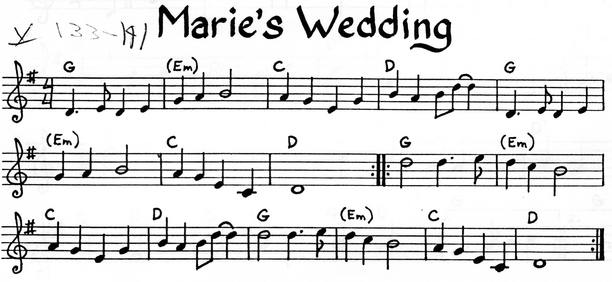Simple Contra Dance Piano |
June 7th, 2011 |
| contra, piano, simple contra dance piano |
The most critical thing when playing rhythm for dancers is to stay right on the beat. If you drift off the beat because you're playing something that is too complex for you, it doesn't matter how nice it would sound if you got it right, you're not being fun to dance to. So we'll start simple and build up.
Listen to the tune or look at the picture; whichever you're most comfortable.
To fit a standard contra dance, a tune needs to be 64 beats broken down into 8 8-beat phrases. Each of those beats is a step the dancers take. To dance a dosido, for example, the dancers take eight steps, which match to eight beats of music. So 8 8-beat phrases means there's time in one time through a dance to dosido eight times. Not a very interesting dance. It's not a coincidence that the music is in eight beat phrases and that a dosido takes eight beats of music: the phrasing of the music helps tell the dancers when to stop one figure (dosido) and start the next (circle left). Most figures are eight beats, though some are sixteen or four and a few are something weirder.
Most tunes that work well for dancing are two sixteen beat two phrase parts, each repeated once. That's a mouthful. Ok. There's an A part followed by a B part. Because they're repeated we can call them "A1 A2 B1 B2". Those are your major landmarks in the tune. They're also the terms callers will use when identifying a dance to you. They might tell you a dance has balances "at the top of the B1", information that will eventually be useful to you, but you can ignore for now.
This tune is no exception. The music does one thing (A1), does it again (A2), then does something else (B1) and does that again (B2). Luckily for us, it happens that the same chords work for the A and the B. And even within a part, you're playing the same chord pattern twice, once for each phrase. The chords are:
A: |: G Em C D
G Em C D :|
B: |: G Em C D
G Em C D :|
|: |: |: G Em C D
:| :| :| but someone would hit you.)
You're going to be playing bass with your left hand and chords with your right. Let's get a simple left hand first. For each of those chords written up there, play the note that is the name of the chord, twice before moving on. So: G G E E C C D D G G ....
These notes are the down beats. If you're working from written music, there should be two of these per measure. On each of these notes the dancers will take a step. It's only comfortable to contra dance within a narrow range of cadences, between about 108bpm and 122bpm. Most dancing wants to go about 118. This means that it should take you about a minute to play 118 down beats. You can use a metronome for this, or you can use a clock. A clock goes at 60bpm, so if you play two down beats each second you'll be within dancable tempo, though somewhat on the fast side.
The right hand mostly plays chords. These chords go on the off beats. That is, they go in the spaces between the down beats. Which sounds like this
We need to figure out how to turn chord names into piano keys. This was simple for the bass notes, because we could just match up the chord names to notes. For chords it's a little more compex. I'll talk more about it later, but for now it will work just to specify some. Try the following:
Most piano players will play "inversions" with their right hands, which means they'll play those notes in a different order. The idea is that you can make it easier on your hand moving it less, and that different inversions have a different feel. I've been happy to just play simple chords with no inversions, but maybe that's me being weird.
Play around with this, get so you can play all the chords on the chart just by thinking which one you want to play next. It won't sound too exciting yet, but I'll write more later about how to make the left hand more interesting.
Next: Interesting Left Hand
- Simple Contra Dance Piano: Interesting Left Hand
- More Mailbag
- Less Simple Contra Dance Piano
- Chord Notation
Comment via: facebook, substack